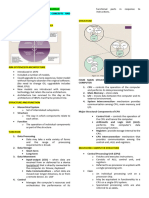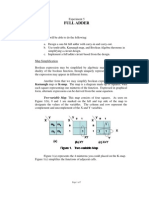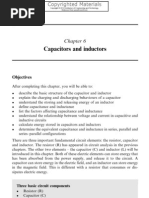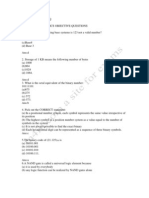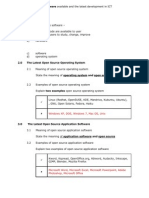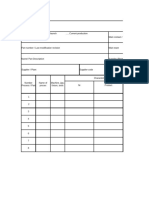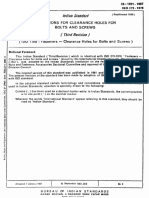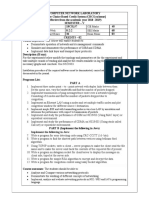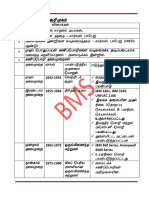Combinational Circuits
Uploaded by
swathi5807Combinational Circuits
Uploaded by
swathi5807Digital Electronics
Combinational & Sequential Circuits
SAMPLE OF THE STUDY MATERIAL PART OF CHAPTER 5 Combinational & Sequential Circuits
5.1 Introduction
Digital circuits can be classified into two types: Combinational digital circuits and Sequential digital circuits.
5.2 Combinational Digital Circuits
Combination Logic Circuits are made up from basic gates (AND, OR, NOT) or universal gates (NAND, NOR) gates that are "combined" or connected together to produce more complicated switching circuits. These logic gates are the building blocks of combinational logic circuits. An example of a combinational circuit is a decoder, which converts the binary code data present at its input into a number of different output lines, one at a time producing an equivalent decimal code at its output. In these circuits the outputs at any instant of time depends on the inputs present at that instant only. For the design of Combinational digital circuits Basic gates (AND, OR, NOT) or universal gates (NAND, NOR) are used. Examples for combinational digital circuits are Half adder, Full adder, Half subtractor, Full subtractor, Code converter, Decoder, Multiplexer, Demultiplexer, Encoder, ROM, etc.
Fig. 5.1 Combinational Digital Circuit
Page : 218
Digital Electronics
Combinational & Sequential Circuits
5.3 Classification of Combinational Logic
Fig.5.2 Combinational Digital Circuit
5.4 Sequential Digital Circuits
Sequential logic differs from combinational logic in that the output of the logic device is dependent not only on the present inputs to the device, but also on past inputs; i.e., the output of a sequential logic device depends on its present internal state and the present inputs. This implies that a sequential logic device has some kind of memory of at least part of its ``history'' (i.e., its previous inputs). A simple memory device can be constructed from combinational devices with which we are already familiar. By a memory device, we mean a device which can remember if a signal of logic level 0 or 1 has been connected to one of its inputs, and can make this fact available at an output. A very simple, but still useful, memory device can be constructed from a simple OR gate, as shown in Figure below:
Fig. 5.3 Sequential Digital Circuit
Page : 219
Digital Electronics
Combinational & Sequential Circuits
In this memory device, if A and Q are initially at logic 0, then Q remains at logic 0. However if the single input A ever becomes a logic 1, then the output Q will be logic 1 ever after, regardless of any further changes in the input at A. In this simple memory, the output is a function of the state of the memory element only; after the memory is ``written'' then it cannot be changed back. However, it can be ``read.'' Such a device could be used as a simple read only memory, which could be ``programmed'' only once. Often a state table or timing diagram is used to describe the behavior of a sequential device. Figure 5.4 shows both a state table and a timing diagram for this simple memory. The state table shows the state which the device enters after an input (the ``next state''), for all possible states and inputs. For this device, the output is the value stored in the memory
Present State 0 0 1 1 State table Input Next State A 0 0 1 1 0 1 1 1 Output 0 1 1 1 A time
Fig. 5.4 Sequential Circuit Timing Diagram Note that the output of the memory is used as one of the inputs; this is called feedback and is characteristic of programmable memory devices. (Without feedback, a ``permanent'' electronic memory device would not be possible.) The use of feedback in a device can introduce problems which are not found in strictly combinational circuits. In particular, it is possible to inadvertently construct devices for which the output is not determined by the inputs, and for which it is not possible to predict the output. A simple example is an inverter with its input connected to its output. Such a device is logically inconsistent; in a physical implementation the device would probably either oscillate from 1 to 0 to 1 or remain at an intermediate value between logic 0 and logic 1, producing an invalid and erroneous output. Examples for sequential digital circuits are Registers, Shift register, Counters etc.
Page : 220
Digital Electronics
Combinational & Sequential Circuits
Half Adder: A half adder is a logical circuit that performs an addition operation on two binary digits. The half adder produces a sum and a carry value which are both binary digits. X 0 0 1 1 Sum = Carry = XY X Y H. A. Sum Carry X Y Sum = X Carry = XY Fig 5.5 Half Adder Y Y 0 1 0 1 Carry 0 0 0 1 Sum 0 1 1 0
Half Subtractor: The half-subtractor is a combinational circuit which is used to perform
subtraction of two bits. It has two inputs, X (minuend) and Y (subtrahend) and two outputs Difference and Borrow. X 0 0 1 1 Y 0 1 0 1 Borrow 0 1 0 0 Diff. 0 1 1 0 Diff. = X = XY + XY X Y Borrow = X Y X Y H.S. Diff. = X
Borrow =X
Fig. 5.6 Half Subtractor Half adder can be converted into half subtractor with an additional inverter. Full adder: Full adder circuit adds three bit binary numbers (X,Y,Z) & outputs two nos. of one bit binary numbers, Sum & Carry.
Page : 221
Digital Electronics X 0 0 0 0 1 1 1 1 Y 0 0 1 1 0 0 1 1 Z 0 1 0 1 0 1 0 1
Combinational & Sequential Circuits Sum 0 1 1 0 1 0 0 1 X Y Z Sum X Y Z F.A. Sum Carry
Carry 0 0 0 1 0 1 1 1
Carry
Fig. 5.7 Full Adder Full adder can be implemented by using two half adders and an OR gate. X Y Z X Y Z H.A. H.A. Sum Carry
Sum
Carry
Fig. 5.8 Full Adder Full subtractor: It subtracts one bit from the other by taking pervious borrow into account and generates difference and borrow
Page : 222
Digital Electronics
Combinational & Sequential Circuits X Y Z
Truth Table X 0 0 0 0 1 1 1 1 Y Z 0 0 0 1 1 0 1 1 0 0 0 1 1 0 1 1
XYZ Diff. 0 1 1 0 1 0 0 1 Diff. X Y Z Diff. Borrow Diff. =X Borrow = Z Borrow
Borrow 0 1 1 1 0 0 0 1
F.S.
Fig. 5.9 Full Subtractor Full subtractor can be implemented by using two half- subtractors and an OR gate. X Y Z X Y Z H.S H.S Diff.
Borrow
Diff.
Borrow
Fig. 5.10 Full Subtractor Full adder can be converted into full subtractor with an additional inverter. Four bit binary parallel adder can be constructed by using three full adders and one half adder or by using four full adders with input carry for least significant bit full adder is zero. Four bit binary parallel adder shown in figure is also called as Ripple carry adder.
Page : 223
Digital Electronics B3 A3 B2 A2
Combinational & Sequential Circuits B1 A1 B0 A0
FA3 Cout S3 B3 A3
FA2 S2 B2 A2
FA1 S1 B1 A1
FA0 S0 B0 A0
Cin=0
FA3 Cout S3
FA2 S2
FA1 S1
HA S0
Fig. 5.11 Binary Parallel Adder Carry Look- Ahead adder is faster than ripple carry adder.
Example:
Implement Boolean function F = using half adder.
Solution:
F = AB = AB = (AB) A B HA C C Fig. 5.12 Decoder: A decoder is a logic circuit that converts an n bit binary input code into M (=2n) output lines such that each output line will be activated for only one of the possible combinations of inputs. (OR) A decoder is a Combinational circuit that converts binary information from n input lines to a maximum of 2n unique output lines. E.g. 2 4 line Decoder (it is also called one four line decoder)
Page : 224
C S HA S C F= (AB) C
Digital Electronics
Combinational & Sequential Circuits
Decoders are available in two different types of output forms: (1) Active high output type decoders and (2) Active low output type of decoders. Active high output type of decoders are constructed with AND gates and active low output type of decoders are constructed with NAND gates. Truth table of active high output type of decoder is given below: Y X Y 0 0 0 1 1 0 1 1
1 0 0 0
0 1 0 0
0 0 1 0
0 0 0 1
X 2 Y
Fig. 5.13 Binary Decoder with Active High Output Active low output types of decoders will give the output low for given input combination and all other outputs are high. Truth table of active low output type of decoder Y X Y 0 0 0 1 1 0 1 1
0 1 1 1
1 0 1 1
1 1 0 1
1 1 1 0
X 2 Y
Fig. 5.14 Binary Decoder with Active Low Output 3 to 8 line decoder is also called Binary-to-Octal decoder or converter. It is also called 1of 8 decoder, because only one of the 8 outputs is active at a time.
Page : 225
Digital Electronics
Combinational & Sequential Circuits
Decoders are widely used in the memory system of computer, where they respond to the address code input from the CPU to activate the memory storage location specified by the address code. Decoders are also used to convert binary data to a form suitable for displaying on decimal read outs. Decoders can be used to implement combinational circuits, Boolean functions etc.
Example: Implement full adder with a decoder. Solution:
S(x, y, z) = C(x, y, z) =
X Y Z
decoder
Fig 5.15
Example:
Implement 3 decoder using decoder.
Solution:
Page : 226
Digital Electronics
Combinational & Sequential Circuits
Fig 5.16 Demultiplexer: A decoder with enable input, acts as demultiplexer. "Demultiplexer", is a logical circuit that takes a single input source and sends it to one of several 2n possible output lines. The selection of specific output line is controlled by the bit values of n selection lines. E 1 0 0 0 0 A X 0 0 1 1 B X 0 1 0 1 E i/p
0 1 0 0 0
0 0 1 0 0
0 0 0 1 0
0 0 0 0 1
A Fig. 5.17 Binary Demultiplexer
5.5 Multiplexer
A multiplexer or mux is a device that selects one of several analog or digital input signals and forwards the selected input into a single line. A multiplexer of 2n inputs has n select lines, which are used to select which input line to send to the output.
Page : 227
Digital Electronics
Combinational & Sequential Circuits Truth table 4 MUX Y 0 0 1 1 0 1 0 1 Y
Fig. 5.18 Binary Multiplexer Multiplexers can be used for the implementation of Boolean functions, combinational circuits. They can also used for parallel to serial conversion. Multiplexer is also called data selector or universal circuit. All three variable Boolean equations can be implemented by using 8 1 multiplexer without using any additional gates. Some but not all three variable Boolean equations can also be implemented with 4 1 mux without using any additional gates.
Example: Implement Boolean function F(A, B, C) = Solution: Truth table
A 0 0 0 0 1 1 1 1 B 0 0 1 1 0 0 1 1 C 0 1 0 1 0 1 0 1 F 0 1 0 1 0 1 1 0 Fig 5.19 A B C C C Y
with
mux
Page : 228
Digital Electronics
Combinational & Sequential Circuits
When AB = 00, F is equal to C, similarly for all other combinations of AB, input to mux is defined in terms of C. Encoder: A decoder identifies a particular code present at the input terminals of the circuit. The inverse process is called Encoding.An Encoder has number of inputs (2n) one and only one of which is in the high state or active, and an n-bit code is generated upon which of the inputs is excited. An encoder is a digital function that produces a reverse operation from that of a decoder. An encoder has (2n or less) input lines and n output lines. The output lines generate the binary code for the input variables. An example of an encoder shown in fig. The octal to binary encoder consists of eight inputs, one for each of the digits, and three outputs that generate the corresponding binary number. The encoder in figure below assumes that only one input line can be equal to 1 at any time; otherwise the circuit has no meaning. Note that the circuit has eight inputs and could have =256 possible input combinations. Only eight of these combinations have any meaning. The other inputs combinations are dont care conditions.
Fig. 5.20 Octal to Binary Encoder ROM (read Only Memory): ROM is nothing but the combination of decoder and Encoder. It is a semi conductor memory and which is a permanent memory, ROM can also be defined as a Simple Code conversion unit. M outputs N inputs Fig. 5.21
Page : 229
Digital Electronics
Combinational & Sequential Circuits
ROM = Fixed AND, Programmable OR PAL = Programmable AND, Fixed OR PLA = Programmable AND, Programmable OR.
Important Points
Two cross coupled inverters will form a basic latch which can store one bit of information. Flip-flops: Flip-Flop is also called Bistable multivibrator. It can store one bit of information. In a flip-flop one output is always complement of the other output. Flip-flop has two stable states.
5.6 Clocked S-R Flip-flop
The clocked SR flip-flop shown in Figure below consists of a basic NOR flip-flop and two AND gates. The outputs of the two AND gates remain at 0 as long as the clock pulse (or CP) is 0, regardless of the S and R input values. When the clock pulse goes to 1, information from the S and R inputs passes through to the basic flip-flop. With both S=1 and R=1, the occurrence of a clock pulse causes both outputs to momentarily go to 0. When the pulse is removed, the state of the flip-flop is indeterminate, ie., either state may result, depending on whether the set or reset input of the flip-flop remains a 1 longer than the transition to 0 at the end of the pulse. Q S R Q(t+1) R 0 0 0 0 0 0 1 0 Q 0 1 0 1 0 1 1 Indeterminate CP 1 0 0 1 (clock pulse) 1 0 1 0 1 1 0 1 S 1 1 1 indeterminate (a) S-R Flip-flop Logic diagram (b) S-R Flip-flop Truth table
Fig. 5.22 Clocked SR flip-flop The disadvantage of S-R flip-flop is for S=1, R=1 output cannot be determined. This can be eliminated in J-K flip-flop. S-R flip flop can be converted to J-K flip-flop by using the two equation S=JQ and R= KQ.
Page : 230
Digital Electronics
Combinational & Sequential Circuits
5.7 JK-flip-flop
A JK flip-flop is a refinement of the SR flip-flop in that the indeterminate state of the SR type is defined in the JK type. Inputs J and K behave like inputs S and R to set and clear the flipflop (note that in a JK flip-flop, the letter J is for set and the letter K is for clear). When logic 1 inputs are applied to both J and K simultaneously, the flip-flop switches to its complement state, ie., if Q=1, it switches to Q=0 and vice versa. A clocked JK flip-flop is shown in figure below. Output Q is ANDed with K and CP inputs so that the flip-flop is cleared during a clock pulse only if Q was previously 1. Similarly, ouput Q' is ANDed with J and CP inputs so that the flip-flop is set with a clock pulse only if Q' was previously 1. Note that because of the feedback connection in the JK flip-flop, a CP signal which remains a 1 (while J=K=1) after the outputs have been complemented once will cause repeated and continuous transitions of the outputs. To avoid this, the clock pulses must have a time duration less than the propagation delay through the flip-flop. The restriction on the pulse width can be eliminated with a master-slave or edge-triggered construction. The same reasoning also applies to the T flip-flop presented next.
K
Q CP
J K
CP J
(a) J-K Flip-flop Logic diagram
(b) Graphical symbol
Q 0 0 0 0 1 1 1 1
J 0 0 1 1 0 0 1 1
K 0 1 0 1 0 1 0 1
Q(t+1) 0 0 1 1 1 0 1 0
(C) J-K Flip-flop Transition table Fig. 5.23 Clocked JK flip-flop
Page : 231
Digital Electronics Truth table 0 0 1 1 0 1 0 1 J Q 0 1 Q K
Combinational & Sequential Circuits
S Clk
P Q
J Clk K
R C
Fig 5.24 Race around problem is present in the J-K flip flop, when both J=K=1. Toggling the output more than one during the clock pulse is called Race around Problem. The race around problem in J-K flip-flop can be eliminated by using edge triggered flip-flop or master slave J-K flip flop or by the clock signal whose pulse width is less than or equal to the propagation delay of flip-flop. Master-slave flip-flop is a cascading of two J-K flip-flops. Positive or direct clock pulses are applied to master and inverted clock pulses are applied to the slave flip-flop.
5.8 D-flip-flop
The D flip-flop shown in figure below is a modification of the clocked SR flip-flop. The D input goes directly into the S input and the complement of the D input goes to the R input. The D input is sampled during the occurrence of a clock pulse. If it is 1, the flip-flop is switched to the set state (unless it was already set). If it is 0, the flip-flop switches to the clear state. K Q CP CP D Q
(a) D Flip-flop Logic diagram with NAND gates
(b) D Flip-flop Graphical symbol
Page : 232
Digital Electronics Q 0 0 1 1 D 0 1 0 1
Combinational & Sequential Circuits Q(t+1) 0 1 0 1
(C) D Flip-flop Transition table Fig. 5.25 Clocked D flip-flop It is also called a Delay flip-flop. By connecting an inverter in between J and K input terminals, D flip-flop is obtained. K always receives the compliment of J. Truth table
D 0 1
J Clk K
0 1
Q Q
D Clk
Q Q
Fig. 5.26 Implementation of D Flip Flop Using JK Flip Flop D flip-flop is used to provide delay. The bit on the D line is transferred to the output at the next clock pulse.
5.9 T Flip-flop
The T flip-flop is a single input version of the JK flip-flop. As shown in figure below, the T flipflop is obtained from the JK type if both inputs are tied together. The output of the T flip-flop "toggles" with each clock pulse.
K CP
Q CP
T K
(a) T Flip Flop Logic diagram
(b) T Flip Flop Graphical symbol
Page : 233
Digital Electronics Q 0 0 1 1 T 0 1 0 1
Combinational & Sequential Circuits Q(t+1) 0 1 1 0
(C) T Flip-flop Transition table Fig. 5.27 Clocked T flip-flop Truth table T 0 1 T
J Clk K
Q Q
T Clk
Q Q
Fig. 5.28 Implementation of T Flip Flop Using JK Flip Flop If X KHz clock signal is applied to a T flip flop when T=1, then the output (Q) signal frequency is given by X/2KHz. Thus it acts as a frequency divider.
Setup Time (t s ): Time interval immediately preceding the active transition of clock signal
during which the control input must be maintained at the proper level.
Hold Time (t H ): The time interval immediately following the active transition of the clock
signal during which the synchronous control input must be maintained at the proper level.
Page : 234
Digital Electronics
Combinational & Sequential Circuits
Synchronous Control i/p
Synchronous Control i/p
Clock
Clock
Set up time Fig. 5.29 Setup & Hold Time Representation
Hold time
5.10 Registers and shifts registers:
A register is a group of flip-flops used to store binary information. An n-bit register can store n-bit information A register which is able to shift the information either from left to right or from right to left is called a shift register. Shift register can perform four different operations. 1. Serial input Parallel output. 2. Serial input 3. Parallel input 4. Parallel input Serial output Parallel output Serial output.
Universal Shift Register: A register which is able to shift the information from left to
right or from right to left and which can perform all four operations is called universal shift register.
Applications of Shift registers:
1. Serial to parallel conversion (It is also called spatial to temporal code conversion). 2. Parallel to serial conversion (It is also called temporal to spatial code conversion). 3. Sequence generator.
Page : 235
Digital Electronics
Combinational & Sequential Circuits
4. Multiplication and Division. 5. Ring counter and twisted ring counter. 6. Digital delay line (serial input and serial output operations). Left shift operation is nothing but multiplied by 2. Eg: Q 3 Q 2 Q1 Q0
=5
= 10
Shift left by n positions is equivalent to multiplication by 2n. If least significant bit = 0, then right shift operation by one position is same as Division by 2. Eg: Q 3 Q 2 Q 1 Q 0
=10
=5
If L.S.B = 1, then right shift operation gives integer division by 2. Eg: Q 3 Q 2 Q 1 Q 0
=5
0 0
=2 (instead of 2.5)
Ring Counter: Shift register can be used as ring counter when Q 0 output terminal is
connected to serial input terminal. An n-bit ring counter can have n different output states. It can count n-clock pulses. Ring Counter
Page : 236
Digital Electronics
Combinational & Sequential Circuits
clk 001 100 010
Fig. 5.30 Mod 3, divide by 3 counter, N : 1 counter Twisted Ring counter: It is also called Johnsons Ring counter. It is formed when output terminal is connected to the serial input terminal of the shift register. An n-bit twisted ring counter can have maximum of 2n different output states. Twisted Ring Counter is also called Johnson counter.
clk 000 100 001 110 011 111
Fig. 5.31 Mod 6, divide by 6, 2N: 1 counter
5.11 COUNTERS
The Counter is driven by a clock signal and can be used to count the number of clock cycles. Counter is nothing but a frequency divider circuit. Two types of counters are available: 1. Synchronous. 2. Asynchronous.
Page : 237
Digital Electronics
Combinational & Sequential Circuits
Synchronous counters are also called parallel counters. In this type clock pulses are applied simultaneously to all the flip-flops. Asynchronous counters are also called Ripple or serial counters. In this type of counters the output of one flip-flop is connected to the clock input of next flip-flop and so on.
Ripple counter (Asynchronous)
1 clk 1
J CL K
J CL K
J CL
K 1
Fig. 5.32 Ripple counter
Combinational circuit which decides whether up counter or down counter
Q clk X
Fig. 5.33 For up counter, X = 1 So, clk = Q For down counter, X = 0 So, clk = A counter having n-flip-flops can have 2n output states i.e. it can count 2n clock pulses (0 to 2n 1). The largest binary number that can be represented by an n-bit counter has a decimal equivalent of (2n - 1). Example. : n = 3, then 2n - 1 = 23 - 1 = 7. A counter can be made to count either in the up mode or in the down mode. Synchronous counters are faster than asynchronous counters.
Page : 238
Digital Electronics
Combinational & Sequential Circuits
The modulus of a counter is the total number of states through which the counter can progress. For example mod-8 counter is having 8 different states (000 to 111). The output signal frequency of Mod-n counter is 1/n th of the input clock frequency. Hence that counter is also called divide by n counter. The number of flip-flops (n) required to construct Mod N counter can be obtained from the following formula: 2n-1 < N 2n. A decade counter is also called Mod- 10 or divide by 10 counter requires 4 flip-flops. Any binary counter can be a modulus counter where as the modulus counter need not be a binary counter. Six flip-flops are required to construct mod-60 counter. Two types of synchronous counters are available. 1. Series carry 2. Parallel carry.
Page : 239
You might also like
- Computer Architecture and Organization ReviewerNo ratings yetComputer Architecture and Organization Reviewer14 pages
- Data Collection Manager System Administrator's GuideNo ratings yetData Collection Manager System Administrator's Guide486 pages
- Multisim Tutorial & Assignment May2019 AmendedNo ratings yetMultisim Tutorial & Assignment May2019 Amended15 pages
- Digital Electronics (Combinational and Sequential Circuits)No ratings yetDigital Electronics (Combinational and Sequential Circuits)22 pages
- Design of Electrical Circuits using Engineering Software ToolsFrom EverandDesign of Electrical Circuits using Engineering Software ToolsNo ratings yet
- Chapter 4: Basics of Digital Electronics: Logic GatesNo ratings yetChapter 4: Basics of Digital Electronics: Logic Gates19 pages
- Basic Flip Flops-SR Flip Flop, JK Flip Flop, D Flip Flop, T Flip Flop, Circuits100% (1)Basic Flip Flops-SR Flip Flop, JK Flip Flop, D Flip Flop, T Flip Flop, Circuits11 pages
- Chapter 5: Counters: Ee 202 Digital ElectronicsNo ratings yetChapter 5: Counters: Ee 202 Digital Electronics59 pages
- EC8553 Electron Devices and Circuits Question BankNo ratings yetEC8553 Electron Devices and Circuits Question Bank24 pages
- Chap 2 Number Systems Operations and CodesNo ratings yetChap 2 Number Systems Operations and Codes28 pages
- Chapter 8 - Memory Storage Devices Question Answers100% (1)Chapter 8 - Memory Storage Devices Question Answers4 pages
- Karnaugh Maps - Rules of Simplification: Grouping Ones100% (1)Karnaugh Maps - Rules of Simplification: Grouping Ones14 pages
- Chapter 5 - Combinational Logic (EEEg4302)No ratings yetChapter 5 - Combinational Logic (EEEg4302)41 pages
- New Linear Intergrated Circuits Lab ManualNo ratings yetNew Linear Intergrated Circuits Lab Manual71 pages
- Operating Instructions: DL-6MB High-Capacity Lowspeed Refrigerated CentrifugeNo ratings yetOperating Instructions: DL-6MB High-Capacity Lowspeed Refrigerated Centrifuge29 pages
- BSFJ78G29 Satellite Tuner: Roduct NformationNo ratings yetBSFJ78G29 Satellite Tuner: Roduct Nformation3 pages
- ITCAM For Microsoft Applications BizTalk Server Agent V6.3.1.2 Troubleshooting GuideNo ratings yetITCAM For Microsoft Applications BizTalk Server Agent V6.3.1.2 Troubleshooting Guide70 pages
- DMB-6100E IP To Analog Modulator User Manual - DigicastNo ratings yetDMB-6100E IP To Analog Modulator User Manual - Digicast26 pages
- PSA Notes Full - PPT (Compatibility Mode)No ratings yetPSA Notes Full - PPT (Compatibility Mode)48 pages
- 240V Class: To 175 HP 480V Class: 1 To 1000 HP 600V Class: 2 To 250 HPNo ratings yet240V Class: To 175 HP 480V Class: 1 To 1000 HP 600V Class: 2 To 250 HP52 pages
- iTN165-CES (A) Configuration Guide (Rel - 01)No ratings yetiTN165-CES (A) Configuration Guide (Rel - 01)374 pages
- Procedure For Design and Development Control-01No ratings yetProcedure For Design and Development Control-0129 pages
- Opentrack - A Tool For Simulation of Railway NetworksNo ratings yetOpentrack - A Tool For Simulation of Railway Networks9 pages
- 11th Computer Science Question Bank Volume 1 Tamil Medium100% (1)11th Computer Science Question Bank Volume 1 Tamil Medium49 pages
- H - P, L - C T: IGH Erformance OW Urrent RansceiverNo ratings yetH - P, L - C T: IGH Erformance OW Urrent Ransceiver56 pages
- Data Collection Manager System Administrator's GuideData Collection Manager System Administrator's Guide
- Digital Electronics (Combinational and Sequential Circuits)Digital Electronics (Combinational and Sequential Circuits)
- Design of Electrical Circuits using Engineering Software ToolsFrom EverandDesign of Electrical Circuits using Engineering Software Tools
- Chapter 4: Basics of Digital Electronics: Logic GatesChapter 4: Basics of Digital Electronics: Logic Gates
- Basic Flip Flops-SR Flip Flop, JK Flip Flop, D Flip Flop, T Flip Flop, CircuitsBasic Flip Flops-SR Flip Flop, JK Flip Flop, D Flip Flop, T Flip Flop, Circuits
- EC8553 Electron Devices and Circuits Question BankEC8553 Electron Devices and Circuits Question Bank
- Chapter 8 - Memory Storage Devices Question AnswersChapter 8 - Memory Storage Devices Question Answers
- Karnaugh Maps - Rules of Simplification: Grouping OnesKarnaugh Maps - Rules of Simplification: Grouping Ones
- Operating Instructions: DL-6MB High-Capacity Lowspeed Refrigerated CentrifugeOperating Instructions: DL-6MB High-Capacity Lowspeed Refrigerated Centrifuge
- ITCAM For Microsoft Applications BizTalk Server Agent V6.3.1.2 Troubleshooting GuideITCAM For Microsoft Applications BizTalk Server Agent V6.3.1.2 Troubleshooting Guide
- DMB-6100E IP To Analog Modulator User Manual - DigicastDMB-6100E IP To Analog Modulator User Manual - Digicast
- 240V Class: To 175 HP 480V Class: 1 To 1000 HP 600V Class: 2 To 250 HP240V Class: To 175 HP 480V Class: 1 To 1000 HP 600V Class: 2 To 250 HP
- Opentrack - A Tool For Simulation of Railway NetworksOpentrack - A Tool For Simulation of Railway Networks
- 11th Computer Science Question Bank Volume 1 Tamil Medium11th Computer Science Question Bank Volume 1 Tamil Medium
- H - P, L - C T: IGH Erformance OW Urrent RansceiverH - P, L - C T: IGH Erformance OW Urrent Ransceiver

